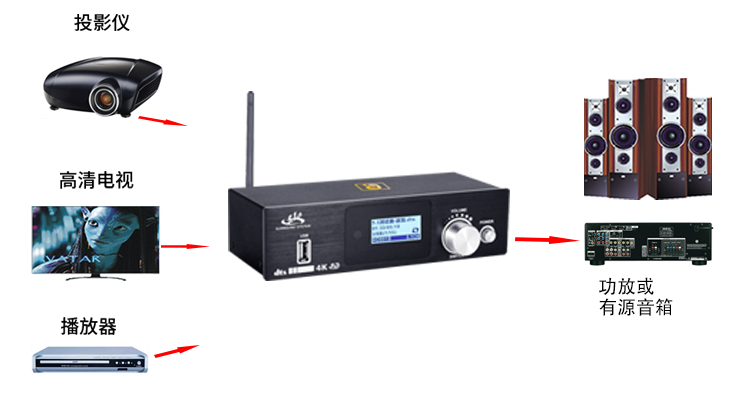
Today’s audio decoders, both in decoding capabilities and functions, are becoming more and more powerful and used more and more widely. They are not only used in audio systems, but also in home audio-visual equipment, such as televisions and TV set-top boxes and other equipment. In the past, decoders were only built to enhance the sound, but with the expansion of functions, the practicality of the current decoders has been greatly improved, from a CD accessory to a unique digital signal processing center.
The past and present of audio decoders
Decoder is referred to as DAC in English, and is called digital-to-analog converter in Chinese. For home audio, the decoder originated from the CD player, which was supposed to be a part of the CD player. Later, the integrated CD player could no longer satisfy the extremely discerning audio users. In this case, The decoder appeared as an independent product.

Digital coaxial output port of CD player
There is no doubt that the decoder at that time was born for CD players. Without a CD player, it will face unemployment because there is no other equipment other than the CD player that needs it to decode. With the development of digital technology, people’s music life has changed. Digital music not only exists in CDs, it exists in the form of files in personal computers, mobile phones, memory cards and even the Internet. As a result, various digital music playback devices came into being, and decoders began to get rid of the shackles of CD players and no longer depend on CD players to survive.
The coaxial output port of the TV box
The first challenge to the CD player was the personal computer. As a result, a decoder that supports USB decoding entered people’s sight, followed by a digital audio player, to find a place for those useless old-fashioned decoders, and the current home audio-visual Many of the devices have digital output functions, such as smart TVs, Internet TV boxes, digital TV set-top boxes, DVD and Blu-ray players, etc.These all provide a place for the decoder. At this time, people discovered that the decoder would not be unemployed without the CD player. Today, when the CD player is showing signs of fatigue, the decoder has gained a new life.

Schematic diagram of playback device output connected to decoder
At present, there are really many products related to decoders. In addition to pure decoding, there are also cross-border products such as decoding headphone amplifiers, decoding preamps, decoding players, etc., which can be described as a hundred flowers blooming.
What’s in the decoder
A standard decoder is composed of digital receiver, clock circuit, digital-to-analog conversion and analog output circuit. The digital receiving part provides various ports (such as coaxial or optical fiber, etc.), which is responsible for the processing of digital signals, and the clock circuit is responsible for the accuracy of digital signal transmission.
The D/A digital-to-analog converter converts the digital signal into an analog signal. At this time, the decoding task is basically completed, but there is still a process to be completed. These signals contain unnecessary high-frequency noise, which must be filtered out, and the analog part is low-pass The processing of the filter (LPF) is complete.
Therefore, we can find some related chips in a decoder, such as digital receiver chips (such as CS8416, etc.), DAC decoding chips (such as ESS9018, etc.), and operational amplifier ICs for analog output (some use discrete circuits). For decoders with USB input, there will also be a USB receiving circuit. At present, the XMOS receiving scheme is commonly used in many decoders, and the decoders that integrate Bluetooth playback must have a Bluetooth receiving module inside.
What is digital input ports does the decoder
Traditional decoders are generally equipped with coaxial (Coaxial) and optical (Toslink) ports. With the advent of computer audio, decoders have more USB decoding functions. In the new generation of decoders, USB ports have become standard. Many decoders are now equipped with AES/EBU balanced ports, and some are even equipped with ports such as i2s and BNC.

Does the decoding chip matter?
The task of the decoder chip is to decode the digital signal and convert it into an analog audio signal, so it is more important, but it is not a condition that determines the sound of a decoder. Some cheap decoders also claim to use the ES9018 performance First-class DAC chip, but the sound performance is not necessarily good. The key is how to use it, and then the peripheral hardware matching. Some manufacturers use low-cost DAC chips, and the sound is still excellent, and the price is not low. In fact, the quality of the digital receiving chip is also very important, and the clock circuit also plays an important role. The design of the analog circuit cannot be ignored. Whether a decoder is excellent or not depends on the overall design and manufacturing process.
Digital signal not to be ignored
Maybe some friends try to use decoders to improve the sound quality of an ordinary CD player, Blu-ray player, or low-cost digital player. This method is indeed feasible, but the improvement may not be large. The problem lies in the digital output quality of these audio sources. Otherwise, there is no such thing as high-end CD turntables and digital turntables.
For example, I have used the same decoder to match 2 CD players and 1 digital player. The sound is completely different. Some are soft and elegant, some are rough and powerful. The final sound style is not all the decoder says. Yes, so the same CD player that uses ESS9018 for decoding, some can be made very thick, some are very neutral. Perhaps some problems are not caused by the decoder, such as low bass, dry sound, insufficient power, lack of dynamics, etc., or they may be caused by the digital output.
 AYINO Technology Co., Ltd.
AYINO Technology Co., Ltd.








您好!Please login